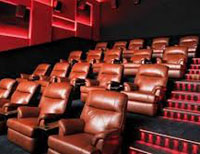 Can you eat your way to an economic recovery? Can you dine and film-watch your way into a boom?
Can you eat your way to an economic recovery? Can you dine and film-watch your way into a boom?
With leisure spending rocketing, the suspicion is growing that the UK’s stuttering economic revival owes a lot to eating out, watching films and taking breaks. Cheap treats are fuelling demand in a way that consumer retail spending is not.
According to the Greene King Leisure Spend Tracker for February 2015, average household spend was £195.31. In May 2014 it was £192.22.
The restaurant and cinema sectors – yoked together in many developments, but whose fortunes could be about to diverge – are the source of much of the heavy economic lifting. Conversion of empty or under-utilised retail floorspace into leisure space – predominantly dining space – has been at the root of the trend (see box, overleaf). But is this leisure-led recovery sustainable?
Food for thought
Ted Schama, joint managing partner at Shelley Sandzer, has been watching the feast of restaurant deals with keen interest. He sees no evidence that leisure spending has plateaued.
“We’re seeing a large-scale version of the small-scale trend to leisure spend we saw in 1991-92 when Café Rouge and Pizza Express first began to expand. In those days retail dominated the high street, and leisure flourished when retail faltered. But retail recovered again. Today, however, we’ve got structural change in the retail sector – not just patchy trading – and the leisure-led recovery is on a much bigger scale,” he says.
Schama adds: “There’s no sign of a slowdown in the trend for converting retail space to leisure space, because the casual-dining chains need more opportunities for growth.”
Land Securities’ head of leisure, Polly Troughton, agrees. “I wouldn’t say leisure was leading the recovery, but it is resilient. The casual-dining operators want more floorspace. That is driven by a mix of growing demand, and also because the business models of their private equity backers require growth.”
Not long ago barely 10% of a shopping centre would be devoted to dining; today that might be 20-25%, and if European and Far Eastern trends are followed, it could be up to 30%.
Meanwhile rental income from leisure tenants is soaring, especially out of London where growth is at its highest. Restaurant rents in the big provincial cities hovered around £30-£40 a sq ft in 2010 – today those figures can be doubled in the best locations. No wonder investors are piling into the leisure sector (see box, below).
But are the cinemas that often anchor leisure schemes doing as well as restaurants?
Picture perfect
The data is equivocal. Audiences have not been as good as some hoped. Gently growing cinema attendance has gone sharply into reverse since 2012 (see box, overleaf). The first quarter of 2015 was up compared to the first quarter of 2014 (39.9m rising to 42.1m) but growth will have to be sustained to meet many exhibitors’ and landlords’ expectations.
If the leisure-led recovery falters, it will be the cinema sector that feels it first, says David Bell, director at Savills.
“The cinema anchor tenants of many leisure schemes have had a torrid time with lower footfall thanks to the lack of Hollywood blockbusters. All eyes will be on the screen later this year when the latest Star Wars and James Bond franchises come out. Yet at the same time as audiences are falling, operator demands for capital contributions have gone up.”
Where once a £1m capital contribution by developers might have been normal, and £1.5m edging close to the top, reports circulate today of £3m capital contributions, with plenty said to be receiving £2.5m. Bell says these figures are pegged to forward-looking aspiration – not current performance – and that opens up room for big disappointments.
“That’s why 2015 could be important – because we’ll discover whether the gamble worked. Operators have improved their fit-out and audience experience, so it’s an interesting time.”
LandSec’s Troughton is not worried. “What comes out of Hollywood makes all the difference to the cinema sector – and last year wasn’t great after years of like-for-like growth.
“But talk to the exhibitors and you find that although audience numbers aren’t up, spend per head is. Despite the audience figures we find out catering tenants are performing well – figures are up – despite cinema figures being down, so we know our dining offer is not reliant on the cinema as anchors.”
Others say that the cinematic live streaming of music, sport and even Xbox-style gaming events will help to consolidate – or even grow – cinema audiences. If this is right, the UK cinema sector will be insulated (to an extent) from Hollywood’s artistic ups and downs.
Dilution dilemmas
There are also home-baked risks in the restaurant sector – not least of which is developers with eyes bigger than their stomach. The result is schemes with more restaurants than the local market can happily digest, a problem compounded by sky-high payments to cinema operators – money that has then to be made up by higher restaurant rents. Too many restaurants mixed with high rents equals trouble, they say.
Bell says: “Certain locations are showing signs of trouble. There are locations where restaurant operators are looking to come out, which is unheard of. But if the landlord is giving £1m extra to the cinema, they have to find the money from somewhere else, so rents go up.”
Troughton agrees. “There are locations where four restaurants, not 10 or 12, would have worked, but landlords added more units to get an immediate profit. They store up long-term problems for themselves by diluting trade.”
Often the smaller provincial locations are at risk, although those involved in these markets say they are not experience problems. Gregory Properties’ Broad Street Plaza Halifax has seven restaurants and a nine-screen cinema as the first phase of a wider development by Gregory Projects. It was funded in 2010 by Santander Corporate Banking in a deal worth £35m and rumours say a sale is likely this year.
Nick Ferris, director at JLL and agent at the Plaza, says: “I think there has been a market misunderstanding on schemes like this. Most of our operators are trading fairly well, but I know there are over-provided schemes, and occupiers are getting a bit sensitive to that.”
Next steps
Nobody is claiming the cinema market is finished, or the restaurant market over-stuffed, but close observers of the leisure scene do not expect it to grow at its current pace for much longer. Attention will then turn to next sectors.
Kidsplay tenants could be one of them. With requirements for up to 60,000 sq ft for child-friendly play spaces, occupiers in this sector could be big news for leisure landlords. Today the market is small – Kidzania is the latest big new entrant – but it is expected to grow fast.
A leisure-led UK economic recovery? It sounds fanciful, but if the evidence of deals and lettings is any guide, it could easily be true.
Feeding the economy?
Leisure spending seems to be leading the UK’s economy recovery.
February’s figures make the point. According to the Greene King Leisure Spend Tracker, spending on dining out has risen by 7% year on year.
Hotel spending was up by 9% compared to overall consumer spending, which was up by 4%, according to Barclaycard, which also reported restaurant spending up by 17% in the first quarter.
Prospects for the rest of the year are also good, says Barclaycard. Almost one quarter (24%) of consumers say they plan to visit more restaurants in the next three months. In line with the rise in non-essential spending in many categories elsewhere, they “have been cautious for a long time” and want to treat themselves for a change.
Howard Archer of IHS Economics says people eat out when they feel richer. “When people feel better off, they are more prepared to go out to restaurants,” he says.
“The fall in petrol prices and muted food prices will give them a bit more discretionary income.”
Marcus Wood, a director in the retail team at DTZ, says: “Leisure spend now seems to be part of a household’s mainstream budget and it still appears to be growing.
“Leisure is also the best performing sub-sector in terms of rental growth. There have recently been lots of new entrants into the market and investor cash for the sector is increasing.”
Investors crowd in
Transaction volumes in the core leisure markets of leisure parks, restaurants, health & fitness, bingo/bowl and cinemas showed a 28% increase from 2013 to 2014, with around £875m transacted in 2014, say researchers at Savills.
Investors have been forced into unusual steps to meet their needs. Legal & General’s LGIM Commercial Lending Limited agreed a £37.5m, 10-year loan to a private client, which is secured against the Hilton London Heathrow Airport Terminal 5 hotel.
The deal is the first hotel lending transaction completed by CLL.
Converted to leisure
As the retail sector flounders, so the leisure sector has filled the gap.
Thomas Rose, head of leisure and restaurants at Cushman & Wakefield, says: “We’re doing a study on this, but I don’t think the pace of conversion of retail to leisure has slowed since at least 2011. The level of success has been fantastic and continually exceeded expectations.”
Gloucester Quays, developed by Peel Group, is a case in point. It opened in 2009 as a purely retail scheme, but in 2011 work began to add a 35,000 sq ft cinema; 15,000 sq ft gym and eight restaurants in 40,000 sq ft of unused retail space. Since the new leisure space opened in 2013 demand has been so strong that another 15,000 sq ft of retail space will be converted to leisure over the summer, adding a handful more restaurants.
“Landlords are looking closely at covenants. They want to know the operational side is sustainable and that the quality of food and service is maintained. Five years ago issues like that were a little overlooked,” adds Rose.











